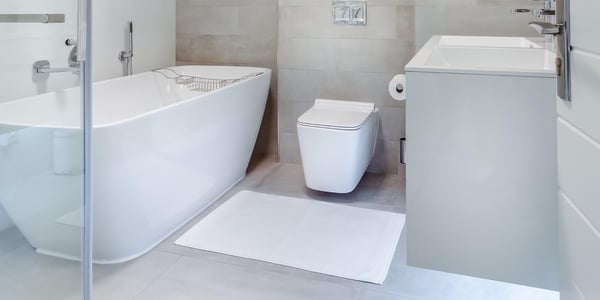Tripping hazards in the home can go unnoticed until they cause an irreversible accident. It is ...
9 Tips to Safely Age-Proof Your Kitchen
As we age, many daily tasks become more difficult. What used to be easy movements can cause injuries. The kitchen is one of the most frequently used rooms, so it is important to make the necessary changes to keep it a safe place for all. Several things can be done to make the kitchen safer, easier to use, and more efficient. This can help keep you or your loved ones safely at home while minimizing risks around the house.
How to Make Your Kitchen a Safe Space for Older Adults
-
Nonslip Flooring or Mats
Slips and falls in the home make up a high percentage of accidents that occur for older adults. In fact, according to the National Institute on Aging, 6 out of every 10 falls occur in the home. They can result in lengthy hospital stays and difficult recoveries. To avoid this, clear all clutter from the floor and ensure it is easy to move around the kitchen. Nonslip mats should be added near the sink, fridge, and high-spill areas. Or, you can choose to switch to a nonslip surface for the entire kitchen floor. Nonslip include cork floors, nonslip antifatigue mats, and other flooring options.
Click here to learn more about tips to prevent falls around the house!
-
Improve the Lighting
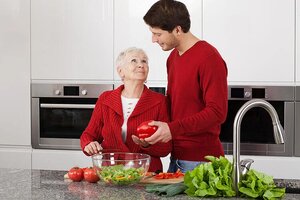 Increase the kitchen lighting and ensure there are no dark areas or large shadows to help create a safer kitchen environment. Switching to LED lightbulbs can save energy while providing a brighter atmosphere. Additional lights can be added to the walls or under the upper cupboards to improve the visibility of the countertops.
Increase the kitchen lighting and ensure there are no dark areas or large shadows to help create a safer kitchen environment. Switching to LED lightbulbs can save energy while providing a brighter atmosphere. Additional lights can be added to the walls or under the upper cupboards to improve the visibility of the countertops.Read this blog post to learn more about safety lighting tips for your home!
-
Purge Unneeded and Rarely Used Items
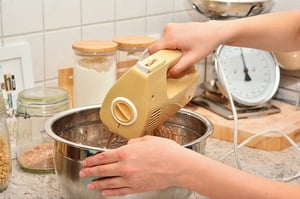 A clear and clutter-free space is easier to move around in and reduces the risk of injury. Cupboards should only have the necessary items, such as one or two light plates that are easy to move and one or two cups that are also light and fit well in the hand. Purchase unbreakable items to reduce the risk of messes and injuries that occur from broken items.
A clear and clutter-free space is easier to move around in and reduces the risk of injury. Cupboards should only have the necessary items, such as one or two light plates that are easy to move and one or two cups that are also light and fit well in the hand. Purchase unbreakable items to reduce the risk of messes and injuries that occur from broken items.
Larger and heavier bowls should be removed and replaced. Plastic bowls can be used for prep work, and lighter bakeware can be a safe and easy alternative to heavy pans. At the same time, items like stoneware should be removed due to their weight and the injury that can occur if it is dropped on a foot or broken and causes cuts.
Small kitchen appliances that are not used often or that are not used safely should be removed. For example, a hand mixer can be used instead of a heavy mixer that must be moved to the counter frequently. Or, find the stand mixer a spot where it can sit permanently and be used without having to be moved. The fewer appliances that must be moved, the fewer that can be dropped or cause injury. As a result, there is less clutter and confusion in the kitchen. -
Tidy Those Cords
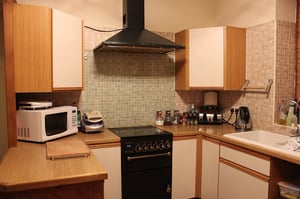 Ensure that all cords for small appliances are placed safely behind the items and not allowed to stretch across the counter or hang in the air. Microwaves should be placed on the counter at an appropriate height with cords tucked behind to avoid catching anything.
Ensure that all cords for small appliances are placed safely behind the items and not allowed to stretch across the counter or hang in the air. Microwaves should be placed on the counter at an appropriate height with cords tucked behind to avoid catching anything.
Items stored in cupboards should be below waist height to keep them from falling or being dropped upon the user. They should not need to be reached for or stretched for, as these movements are more likely to cause injury. Keeping items in the places they are used with the cords protected makes a kitchen safer not just for elderly family members but also for children. A cord that can be cut accidentally can lead to electrocutions and hospital visits.
Cord protectors should be used where necessary. They will contain the cord and prevent it from being damaged, as well as keep them organized and tidy. -
Print Instruction Sheets for Appliances
Consider printing instructions for each appliance. Laminate or put the instructions in a page protector and tape them next to each appliance. Using photos ensures your loved ones can easily follow the instructions, increasing the safe use of these items.
-
Keep Most Used Items in Easy Reach and Set-Up
Reaching for, lifting, and carrying items can increase the risk of injury. They can be dropped or even cause muscle injury. Keep all the heavy and frequently used items, such as coffee pots, stand mixers, microwaves, and toasters, on the counter in place they will be used, with the cords secured.
-
Store Kitchen Knives Separately
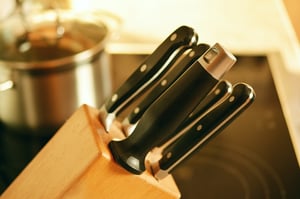 When reaching into a utensil drawer, there can be a risk of being cut by one of the kitchen knives. Knives should be stored separately, such as in a knife block or a different drawer with a knife holder to store them all blades down and enclosed. These can be purchased at dollar stores and home supply stores, and they will hold the knives in place with the blades covered until intentionally removed.
When reaching into a utensil drawer, there can be a risk of being cut by one of the kitchen knives. Knives should be stored separately, such as in a knife block or a different drawer with a knife holder to store them all blades down and enclosed. These can be purchased at dollar stores and home supply stores, and they will hold the knives in place with the blades covered until intentionally removed. -
Pull Out Pantry
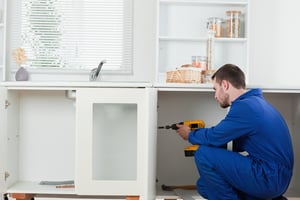 Creating a pantry with shelves that pull out, or installing a set of drawers in the pantry can help prevent injury. These allow for all items to be easily reached without stretching and reaching. If these are not suitable for the space, a lazy susan can be installed to rotate and bring items from the back to the front for easy reach.
Creating a pantry with shelves that pull out, or installing a set of drawers in the pantry can help prevent injury. These allow for all items to be easily reached without stretching and reaching. If these are not suitable for the space, a lazy susan can be installed to rotate and bring items from the back to the front for easy reach. -
Small and Light Fire Suppression Devices
Large fire extinguishers can be heavy and difficult to hold or carry. Obtaining small, light, and easy-to-use fire suppression devices can significantly improve kitchen safety. They do not have a pin to pull and can be held in one hand. They can be found online, at camping or RV supply stores, and at some home supply stores.
Put all these tips together, and make your kitchen a safe and efficient place to prepare meals! Remember, kitchens present all kinds of hazards, from slippery floors to fires, tripping hazards, sharp objects, and more. Take caution when you navigate the kitchen. A bit of organizing and preparation can help prevent nightmares in the house for you and your loved ones. Be safe, and make the most of your kitchen!
Let us know in the comments below - What did we miss? How else do you keep your kitchen safe and tidy?
Related Content:





